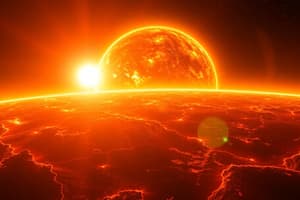Podcast
Questions and Answers
How does nuclear fusion occur in the Sun?
How does nuclear fusion occur in the Sun?
The core's extreme temperature and density enable the nuclear fusion of hydrogen to helium through the proton-proton chain despite electromagnetic repulsion.
What is the only force in nature that can overcome the electromagnetic repulsion between two positively charged nuclei?
What is the only force in nature that can overcome the electromagnetic repulsion between two positively charged nuclei?
The strong force.
How is the strong force that binds protons and neutrons together different from gravitational and electromagnetic forces?
How is the strong force that binds protons and neutrons together different from gravitational and electromagnetic forces?
The strong force is significant only at very small distances and not affected by increased distance, while gravitational and electromagnetic forces drop off gradually.
Why is temperature important in nuclear fusion?
Why is temperature important in nuclear fusion?
Why is the high pressure of the overlying layers of the Sun needed?
Why is the high pressure of the overlying layers of the Sun needed?
What is the proton-proton chain?
What is the proton-proton chain?
What are the sequences of the proton-proton chain?
What are the sequences of the proton-proton chain?
How does the energy from fusion get out of the Sun?
How does the energy from fusion get out of the Sun?
Despite photons travelling at the speed of light, why does it take them a very long time to make any outward progress?
Despite photons travelling at the speed of light, why does it take them a very long time to make any outward progress?
Why does convection occur in the convection zone of the Sun?
Why does convection occur in the convection zone of the Sun?
What happens to energy in the Sun's convection zone?
What happens to energy in the Sun's convection zone?
What do we mean when we say that the Sun is in gravitational equilibrium?
What do we mean when we say that the Sun is in gravitational equilibrium?
Flashcards are hidden until you start studying
Study Notes
Nuclear Fusion Process in the Sun
- Nuclear fusion in the Sun primarily occurs in the core, where extreme temperatures and densities facilitate the fusion of hydrogen into helium via the proton-proton chain.
- Positively charged atomic nuclei, moving rapidly, can overcome electromagnetic repulsion to fuse if they collide with sufficient energy.
Strong Force
- The strong force is the only fundamental force capable of overcoming electromagnetic repulsion between positively charged nuclei, binding protons and neutrons together.
Characteristics of Forces
- Unlike gravitational and electromagnetic forces that diminish with distance (following an inverse square law), the strong force is effective at very short ranges, resembling adhesive qualities over atomic distances and becoming negligible over larger separations.
Importance of Temperature in Fusion
- High temperatures are essential for nuclear fusion as they ensure nuclei collide with enough energy, increasing the likelihood of fusion reactions.
Role of Pressure
- High pressure from overlying layers prevents the hot plasma of the solar core from exploding into space, which is vital for sustaining nuclear reactions.
Proton-Proton Chain Explanation
- The proton-proton chain consists of specific nuclear reactions through which hydrogen is fused into helium, converting 4 protons into one helium nucleus (2 protons + 2 neutrons) while releasing energy.
Steps of the Proton-Proton Chain
- Step 1: Two protons fuse to form a deuterium nucleus (1 proton + 1 neutron).
- Step 2: Deuterium nuclei fuse to create helium-3 (2 protons + 1 neutron).
- Step 3: Two helium-3 nuclei combine to form helium-4 (2 protons + 2 neutrons), releasing 2 excess protons.
Energy Transport from Fusion
- Energy generated from fusion travels outward as photons that move through the radiative zone of the Sun, transitioning from the hotter core to the cooler surface.
Photon Movement in the Sun
- Despite traveling at light speed, photons take a prolonged time to exit the Sun due to frequent interactions with electrons in the dense plasma, resulting in a zigzag path often referred to as a random walk.
Convection in the Sun
- Convection occurs in the Sun's convection zone as hot, less dense gas rises through cooler, denser plasma, mirroring the behavior of hot-air balloons.
Energy Transport in the Convective Zone
- Energy is transported outward in the convection zone by the rising of hot plasma coupled with the sinking of cooler plasma.
Gravitational Equilibrium
- The Sun maintains gravitational equilibrium, balancing the outward pressure from fusion and thermal energy with the inward gravitational pull.
Studying That Suits You
Use AI to generate personalized quizzes and flashcards to suit your learning preferences.




